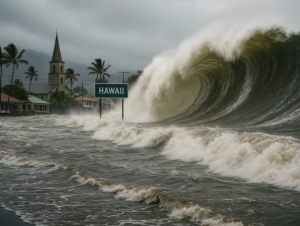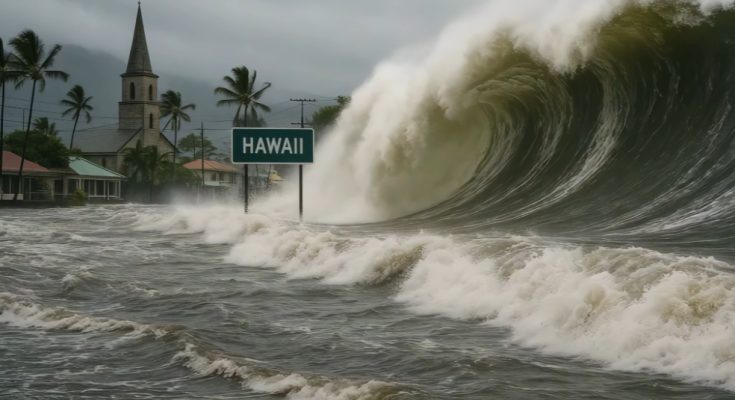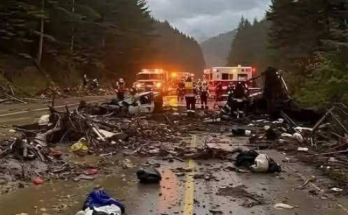First Waves Hit Hawaii After Massive Earthquake Off Russia Triggers Tsunami Alerts Across Pacific
August 4, 2025 – Honolulu, Hawaii
Panic, prayer, and preparation gripped the Pacific Rim today as a massive 8.9-magnitude earthquake struck off the eastern coast of Russia’s Kamchatka Peninsula, triggering widespread tsunami alerts stretching across the Pacific—from Japan to Hawaii to the U.S. West Coast.
Shortly after 3:12 a.m. local time in Russia, the undersea quake—centered approximately 75 miles offshore and 20 miles deep—rattled the region with ferocious intensity. Within 20 minutes, tsunami sirens began to blare in coastal areas from Petropavlovsk-Kamchatsky to Kushiro, Japan, and eventually across thousands of miles of ocean to the Hawaiian Islands and California coast.
First Waves Reach Hawaii
At 9:37 a.m. HST, the first tsunami waves reached Hawaii’s Big Island, sending powerful surges of seawater crashing into Hilo Bay and inundating portions of Kailua-Kona’s waterfront. Though the initial waves were between 2 to 3 feet, local authorities warned the real danger lies in the later surges—which are typically stronger and faster.
“Do not let your guard down. Tsunamis are not single waves—they come in sets, and the second or third wave could be far more destructive,” warned Hawaii Emergency Management Agency (HI-EMA) spokesperson Malia Ho’oku.
As of 10:00 a.m., no fatalities or serious injuries had been reported in Hawaii, but authorities confirmed damage to boats, docks, and coastal businesses in Maui and Oahu. Residents described the surreal experience of watching the ocean recede suddenly—followed by a surge of whitewater engulfing previously dry streets.
Widespread Pacific Warnings
In the hours following the quake, the Pacific Tsunami Warning Center issued alerts and advisories for dozens of nations and territories, including:
-
Japan (entire eastern seaboard under watch)
-
Philippines, Indonesia, Taiwan
-
U.S. Pacific Northwest, including Alaska, Washington, and Oregon
-
South Pacific nations, including Fiji, Tonga, and New Zealand
The Japan Meteorological Agency (JMA) warned of possible waves reaching up to 3 meters (9.8 feet) in northern Japan by early evening local time. Evacuation orders were issued in Hokkaido and parts of Honshu, where emergency sirens echoed across coastal villages.
In the Philippines, the National Disaster Risk Reduction and Management Council (NDRRMC) advised residents in low-lying areas to evacuate immediately. Schools and government offices in coastal provinces were ordered closed.
United States West Coast on High Alert
On the U.S. mainland, the National Weather Service (NWS) issued a tsunami advisory for the entire Pacific coast, from San Diego, California, to Sitka, Alaska. While no mandatory evacuations had been ordered by midmorning, residents in low-lying areas of Los Angeles, San Francisco, and Seattle were advised to move to higher ground.
California Governor Elena Rodriguez activated the state’s emergency operations center, urging residents to “stay informed, stay safe, and stay out of the water.”
“This is not a drill. We do not expect a catastrophic wave at this time, but unpredictable surges can cause major damage and loss of life,” she warned in a press briefing.
The Quake: Deep and Devastating
According to the U.S. Geological Survey (USGS), the undersea megathrust earthquake occurred in a subduction zone, where the Pacific Plate is being forced beneath the North American Plate. This tectonic movement is known for generating some of the most powerful earthquakes in history, including the 2011 Tōhoku earthquake and tsunami.
Initial reports suggest the quake lasted for more than 90 seconds, shaking buildings and knocking out power in parts of eastern Russia. Aftershocks measuring between 6.1 and 6.8 on the Richter scale were recorded within the first two hours.
“This was a major seismic event, and the energy released was enormous,” said Dr. Hiro Tanaka, a geophysicist at the University of Tokyo. “The tsunami generation potential is very high, and the next 24 hours will be critical for all regions bordering the Pacific.”
Panic, Evacuations, and Preparedness
In Hawaii, residents were jolted awake by sirens and emergency text alerts before dawn. Gas stations quickly saw long lines as people fueled up, and supermarkets were swarmed by shoppers grabbing bottled water, flashlights, and non-perishables.
Many hotels evacuated their ground-floor guests, and lifeguards and police officers cleared beaches and tourist zones.
Local hero Keoni Akana, a fisherman from Lahaina, used his personal boat to help secure other vessels in the harbor as the first wave came in:
“We’ve seen small surges before, but this one had power. I just hope it doesn’t get worse. But everyone’s doing their part, that’s what matters.”
Tsunami Timeline: Where It’s Headed Next
As waves ripple across the ocean basin, other nations brace for potential impact.
-
Japan: Arrival expected between 5:30 p.m. and 7:00 p.m. local time
-
U.S. West Coast: Waves predicted between 1:00 p.m. and 3:00 p.m. PST
-
Australia & New Zealand: Expected late tonight (local time)
-
South America (Peru, Chile): Low probability, but monitoring closely
Experts warn that even small tsunami waves can cause dangerous currents, destroy boats, and sweep people off piers and coastal roads.
Looking Back to Look Forward
This event is being compared to the 2004 Indian Ocean tsunami and 2011 Japan disaster, both of which caused massive destruction and loss of life due to delayed evacuation and underestimating the wave’s strength.
But early signs show improved readiness this time. New satellite monitoring, underwater sensors, and international data-sharing have helped speed up warnings and guide evacuation efforts.
“Technology has evolved,” said Dr. Mia Sanchez of NOAA. “We now have real-time modeling that can predict wave travel and impact zones with greater accuracy than ever before.”
What’s Next: Aftershocks and Long-Term Risk
While tsunami watches remain active, geologists caution that aftershocks may continue for days, and landslides or underwater collapses could trigger secondary tsunami waves.
Global leaders have already pledged cooperation in response efforts. The UN Office for the Coordination of Humanitarian Affairs (OCHA) announced it is ready to assist in affected areas, particularly small island nations with limited infrastructure.
Final Thoughts
As of now, the damage appears to be minimal—but the danger is not over. From Russia’s icy coast to Hawaii’s sunlit beaches, from bustling Tokyo to the quiet fishing towns of Oregon, the Pacific remains on edge.
Today’s quake is a reminder: beneath the calm of the ocean lies a powerful, unpredictable force. And sometimes, all it takes is a tremor deep below the surface to shake the entire world above.


